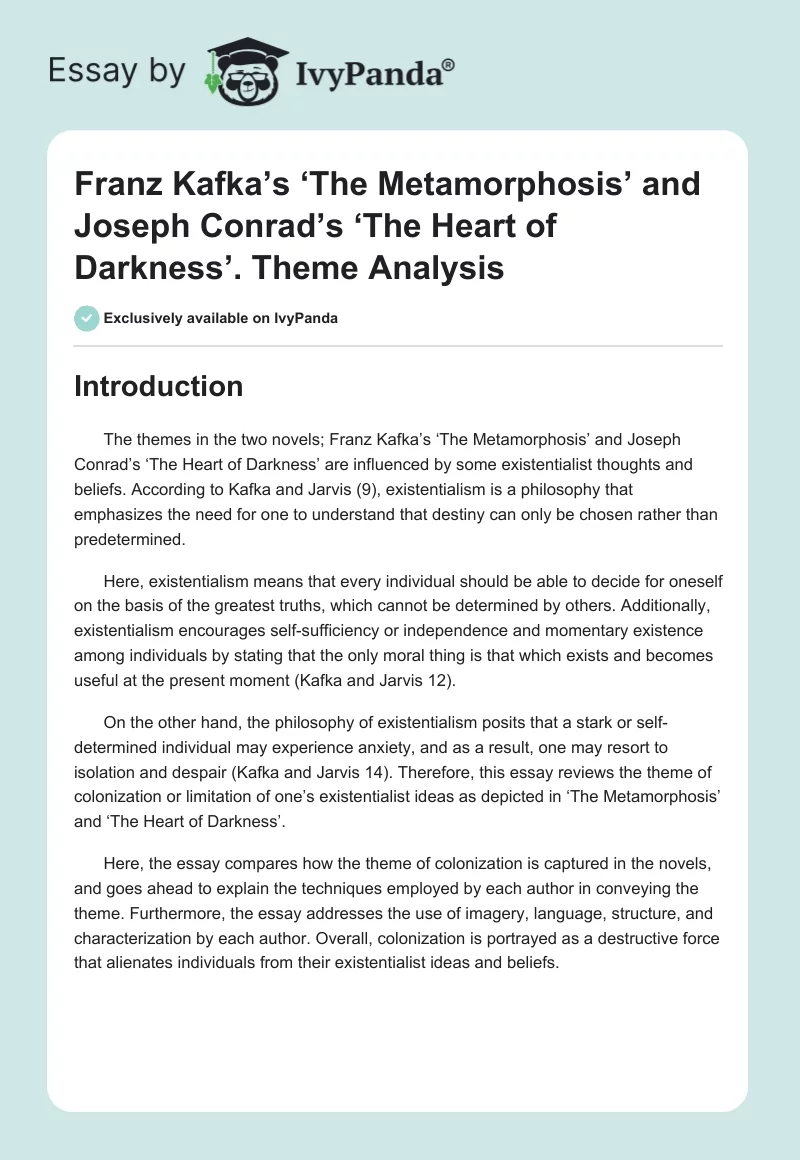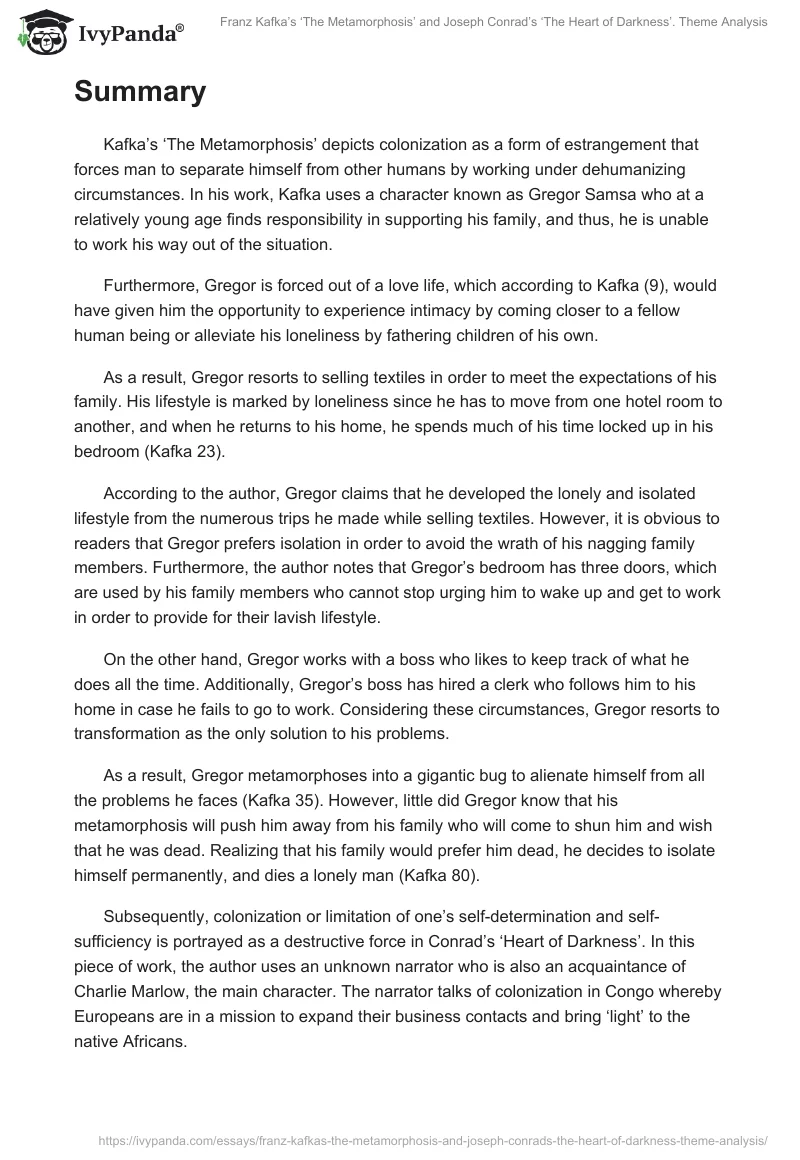Introduction
The themes in the two novels; Franz Kafka’s ‘The Metamorphosis’ and Joseph Conrad’s ‘The Heart of Darkness’ are influenced by some existentialist thoughts and beliefs. According to Kafka and Jarvis (9), existentialism is a philosophy that emphasizes the need for one to understand that destiny can only be chosen rather than predetermined.
Here, existentialism means that every individual should be able to decide for oneself on the basis of the greatest truths, which cannot be determined by others. Additionally, existentialism encourages self-sufficiency or independence and momentary existence among individuals by stating that the only moral thing is that which exists and becomes useful at the present moment (Kafka and Jarvis 12).
On the other hand, the philosophy of existentialism posits that a stark or self-determined individual may experience anxiety, and as a result, one may resort to isolation and despair (Kafka and Jarvis 14). Therefore, this essay reviews the theme of colonization or limitation of one’s existentialist ideas as depicted in ‘The Metamorphosis’ and ‘The Heart of Darkness’.
Here, the essay compares how the theme of colonization is captured in the novels, and goes ahead to explain the techniques employed by each author in conveying the theme. Furthermore, the essay addresses the use of imagery, language, structure, and characterization by each author. Overall, colonization is portrayed as a destructive force that alienates individuals from their existentialist ideas and beliefs.
Summary
Kafka’s ‘The Metamorphosis’ depicts colonization as a form of estrangement that forces man to separate himself from other humans by working under dehumanizing circumstances. In his work, Kafka uses a character known as Gregor Samsa who at a relatively young age finds responsibility in supporting his family, and thus, he is unable to work his way out of the situation.
Furthermore, Gregor is forced out of a love life, which according to Kafka (9), would have given him the opportunity to experience intimacy by coming closer to a fellow human being or alleviate his loneliness by fathering children of his own.
As a result, Gregor resorts to selling textiles in order to meet the expectations of his family. His lifestyle is marked by loneliness since he has to move from one hotel room to another, and when he returns to his home, he spends much of his time locked up in his bedroom (Kafka 23).
According to the author, Gregor claims that he developed the lonely and isolated lifestyle from the numerous trips he made while selling textiles. However, it is obvious to readers that Gregor prefers isolation in order to avoid the wrath of his nagging family members. Furthermore, the author notes that Gregor’s bedroom has three doors, which are used by his family members who cannot stop urging him to wake up and get to work in order to provide for their lavish lifestyle.
On the other hand, Gregor works with a boss who likes to keep track of what he does all the time. Additionally, Gregor’s boss has hired a clerk who follows him to his home in case he fails to go to work. Considering these circumstances, Gregor resorts to transformation as the only solution to his problems.
As a result, Gregor metamorphoses into a gigantic bug to alienate himself from all the problems he faces (Kafka 35). However, little did Gregor know that his metamorphosis will push him away from his family who will come to shun him and wish that he was dead. Realizing that his family would prefer him dead, he decides to isolate himself permanently, and dies a lonely man (Kafka 80).
Subsequently, colonization or limitation of one’s self-determination and self-sufficiency is portrayed as a destructive force in Conrad’s ‘Heart of Darkness’. In this piece of work, the author uses an unknown narrator who is also an acquaintance of Charlie Marlow, the main character. The narrator talks of colonization in Congo whereby Europeans are in a mission to expand their business contacts and bring ‘light’ to the native Africans.
According to Kurtz, one of the most productive station managers in the interior of Congo, the initial approach of the Europeans was to ensure that each company station becomes the main source of better things and a center of trade while improving and humanizing the lifestyles of the natives (Conrad 4-10).
The same idea is also shared by the International Society for the Suppression of Savage Customs, an organization that believes in the civilization of the natives inhabiting Congo. Moreover, other characters such as Marlow’s aunt believe that Europeans including Marlow have the potential to liberate millions and millions of ignorant natives from their unpleasant ideas and beliefs.
However, some Europeans such as Marlow note that colonization is not a pretty thing to do if one had to look at it more deeply. Marlow takes note of the reality of colonization upon observing physically exhausted individuals working under dehumanizing conditions, co-workers who can get away with almost anything in order to please their bosses, earn additional profits and gain recognition, and colonized people who are literally shackled to generate more profit (Conrad 33).
On the other hand, despite Kurtz having a different approach toward the civilization of the natives, he resorts to practicing a different form of colonization in which he ensures that the natives literally worship him.
Kurtz’s approach enables him to bring in more ivory and thus gain the recognition of his superiors. Furthermore, Marlow observes the greatest form of savagery when he visits Kurtz’s office whereby heads of the rebels are placed atop poles to suppress future rebellion from the natives (Conrad 56).
Theme Analysis
From the foregoing discussions, it is certain that colonization may benefit the colonizers in different ways but it can bring hardships, deaths, and sufferings to the colonized people. The two novels describe both the mythical image and the apparent character of the colonized people and their colonizers.
In the two novels, the colonizer is depicted as someone who claims to have certain privileges upon the suppressed and colonized people. Furthermore, the colonizer feels that there is the need to justify his or her privileges by creating a myth that makes him more superior or in much need than the colonized.
Accordingly, Gregor’s family members and his boss on one hand and the Europeans on the other hand are depicted as virtuous and civilized individuals who assume higher capabilities and positions that make them worthy of their contemptible characters. By preferring to ignore the presence of the colonizer, the colonized people would certainly not forget that the colonizer holds his present position unfairly. Therefore, as the colonized rebel, the colonizer becomes increasingly zealous in holding on to his position.
On the other hand, the oppressive character of the colonizer ends the history and the future of the colonized people since they are made to follow the ways dictated by the colonizer. In Conrad’s work, ‘The Metamorphosis’, we note that Gregor’s family members including his boss impose certain constrictions in his life, and thus they force him to forego or ignore certain values of his life. The same also applies to the natives in the interior of Congo who are forced to forego their culture and let the Europeans determine their future.
As a result, with their inability to change the present situation, the colonized retire to a frozen state, and allow their history and future to atrophy. Overall, by allowing the colonizers to determine their future, the colonized loose their freedom, self-determination, and self-sufficiency; the qualities much needed in order for an individual to see the truth and overcome the fear of the unknown.
Conclusion
The essay reviews the theme of colonization as depicted in the two novels, ‘The Metamorphosis’ and the ‘Heart of Darkness’ by comparing how the two authors support the theme in their respective pieces of work, and their use of language, structure, characterization, and imagery to convey the message.
From the discussions above, it is worth noting that the two authors present their characters under different circumstances but achieve to show that colonizers and the colonized appear in different cultures and circumstances. Further, the foregoing discussions show that the two cultures described in the two novels share certain attributes. Here, it is certain that the existentialist ideas hold in that readers can note that the universe is indifferent and very hostile to humankind.
Furthermore, no human being is able to explain his or her existence, and thus, life is approached from different angles relative to individual experience. On the other hand, we note that isolation, despair, and anxiety form an integral part of life. Finally, the truth is purely determined by one’s own conventions rather than external forces. However, the freedom of choice enjoyed by each individual predisposes one to the consequences of his or her actions.
Overall, reading diverse literature and getting to discover mankind’s commonalities enables one to uncover a wide range of premises upon which different literally works are written. Additionally, this experience allows one to take note of the fact that different literally works are based on real-life events and activities, which affect mankind in different ways and under different circumstances. However, these problems do also share common solutions.
Works Cited
Conrad, Joseph. Heart of darkness. New York: Plain Label Books, 1975. Print.
Kafka, Franz. The metamorphosis: literary touchstone. Clayton, Delaware: Prestwick House Inc, 2005. Print.
Kafka, Franz, and Jarvis, Martin. Metamorphosis. New York: Lulu.com, 2008. Print.


